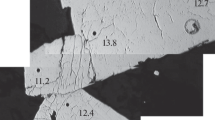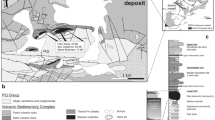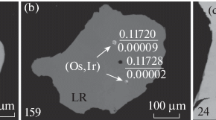Abstract
The sulfur isotope composition was measured in the main morphological types and generations of sulfides composing the ores of the Dzhusa deposit and the contents of trace elements were measured using highly sensitive laser ablation-inductively coupled plasma-mass spectrometry (LA–ICP–MS) for the first time. According to the sulfur isotope geochemistry, we assume that a deep magmatic source made a predominant contribution to the ore-forming fluid. Using the STATISTICA software modules, correlation analysis was performed and the trace element distribution patterns in sulfides were revealed.
Similar content being viewed by others
Avoid common mistakes on your manuscript.
INTRODUCTION
The Dzhusa ore deposit is a prominent ore object in the Southern Urals with an extremely complex evolution. Such features as the commercial contents of Pb and Ba (along with Cu and Zn) in ores, higher alkalinity of ore-bearing volcanics (Kosarev and Artyushkova, 2007), numerous different-aged subvolcanic and intrusive bodies, and intensive different-facies metamorphism (Vikentyev еt al., 2017; Yartsev et al., 2017) allow us to consider the Dzhusa deposit as an unique sulfide–polymetallic deposit among many other (more than 100) copper–pyrite and Cu–Zn pyrite deposits of the Urals. Due to this, any new data on the deposit are of great importance.
THE GEOLOGICAL STRUCTURE OF THE DZHUSA DEPOSIT AREA
The Dzhusa deposit is located (Fig. 1) in the Terensai ore district (Kosarev and Artyushkova, 2007; Yartsev et al., 2017). The deposit is composed of Devonian rocks of the Irendyk, Karamalytash and Ulutau formations, as well as Lower Carboniferous sedimentary deposits (Eremin et al., 1968). The lower part of the section is represented by the Irendyk andesitobasalt formation (upper Emsian–lower Eifelian) (Kosarev and Artyushkova, 2007). The overlying Karamalytash Formation is dated to the Eifelian (Middle Devonian) (Kosarev and Artyushkova, 2007) and is attributed to the basalt–andesite–dacite–rhyolite formation. This formation is subdivided into two subformations: lower Karamalytash (predominantly basalts and andesibasalts) and upper Karamalytash. The latter is subdivided into three units. The lower unit is composed of dacite lavas and tuffs; basalts, andesite-basalts and rhyolites are less common. This unit encloses the Dzhusa ore deposit and a series of ore occurrences: North Dzhusa-І, -ІІ, -ІV and West-Dzhusa (Yartsev et al., 2018). The middle unit is represented by andesibasalts, andesites, and their tuffs with subordinate development of andesitodacites and dacites. The upper unit is composed of dacites, rhyodacites, and their tuffs with thin interbeds of mafic and intermediate rocks and encloses South Dzhusa and North Karabutak ore occurrences (Eremin et al., 1968).
A map of the central site of the open pit of the Dzhusa deposit as of 2013: (1) quartz–sericite–chlorite alteration rocks, (2) andesites, (3) dacites, (4) early gabbro porphyrites, (5) late gabbro porphyrites, (6) diorites of the Magnitogorsk intrusive complex, (7) copper–sulfide and pyrite–polymetallic ores, (8) pyrite ores, (9) geological boundaries (а, reliable, b, proposed), (10) boundaries of open-pit benches with absolute altitudes.
The Dzhusa ore deposit is confined to the local shear zone, which complicates the Terensai anticline. The column-shaped ore bodies are localized in predominantly dacite unit. In total, there are 18 ore bodies, composed of pyrite–polymetallic, copper–pyrite, and pyrite ores. The unit is intruded by sill-like gabbro porphyrite bodies of the Early Eifelian–Early Givetian subvolcanic complex and diorite dykes of the Early Carboniferous Magnitogorsk complex (Yartsev et al., 2017).
MATERIALS AND METHODS
The Isotope sulfur composition of ore minerals of the Dzhusa ore deposit. In order to study the sulfur isotope composition from different morphological types and generations of ore minerals, the sulfide monofractions were extracted (Table 1). Analyses were performed in the Laboratory of Isotope Geochemistry and Geochronology (IGEM RAS). The method of an analysis was given in (Dubinin et al., 2014). The sulfur isotope values obtained for ore minerals from the Dzhusa deposit indicate a deep magmatic source of sulfur dominates, most likely in a ore-bearing fluid (Faure, 1989; V.L. Grinenko and L.N. Grinenko, 1974; Mednokolchedannye…, 1982; Vikentyev, 2004), while one can assume the partial extraction of sulfur from country volcanics of mantle origin. A small shift in the sulfur isotope composition of galena (the latest sulfide), that is, from the total rather narrow range of δ34S = –1.01…+3.16‰ towards negative values, indicates its crystallization from the fluid, affected by an upper crustal (sedimentation-diagenetic, from terrigenous sediments) source at the terminal stages of ore genesis. This is confirmed by an abnormally high proportion of radiogenic lead in its composition (Chernyshev et al., 2008).
Research methods of trace elements in ore minerals. Using LA–ICP–MS (Vikentyev et al., 2016), trace elements in the main generations of ore minerals (Table 2) were analyzed using spot and profile ablation with a quadrupole Thermo XSeries 2 mass-spectrometer coupled to an NWR 213 laser ablation system (analyst V.D. Abramova, Institute of Geology of Ore Deposits, Petrography, Mineralogy, and Geochemistry, Russian Academy of Sciences, Moscow). A spot analysis (the laser beam diameter was 40 μm) was performed for the majority of minerals, while for crystalline–zonal pyrite it was performed in profiles across a pyrite grain.
RESULTS AND DISCUSSION
Regularities in the distribution of trace elements. Based on LA-ICP-MS data, high levels (n‧100 ppm) of the following elements were determined in collomorphic–zonal pyrite: Tl, Sb, Bi, As, Co, and Cr. The As, Co, Sb, and Tl concentrations are most highly variable. When studying crystalline–zonal pyrite, the contents of trace elements were calculated in profiles across segments (blocks), which were recognized on the basis of variations in contents of these four elements, which are usually considered as typical isomorphic admixtures in its composition.
Analysis of the distribution of the mean geometric values of trace element contents in main ore generations (Table 2) revealed the following. A significant increase in Cr content and decrease in the contents of Mn, Ag, Cd, Tl, and Bi are noted from the early pyrite generation (Py1, collomorphic) to the late one (Py2, crystalline–zonal). Chalcopyrite from the early generation (from copper–sulfide and pyrite–polymetallic ores) to the late one (from quartz–sulfide veins, occurred along boundaries of ore bodies and gabbro porphyrites) is characterized by a large increase in Ag content (by almost 80 times, up to a mean geometric value 334 ppm) and a significant decrease in Ga, Cd, and Sn contents. The higher Ag content values (relative to other sulfides) are characteristic of fahlore (the mean geometric value, 858 ppm); the Au content is characteristic of arsenopyrite (up to 57 ppm, mean geometric value, 4 ppm) in comparison with other sulfides (mean geometric value, 0.14–1.82 ppm).
The variations in contents of some metals at the transition from the early generation of ore minerals to the later one can be explained by processes of ore recrystallization and redistribution of elements due to a different degree of their mobility under the metamorphic processes. As an example, when approaching the contact between an ore body and late gabbro-porphyrites, the sulfides demonstrate a decrease in the contents of the majority of trace elements (for example, In, Ga, W, and Sb) as a result of their removal from the crystal lattice of minerals due to contact–metamorphic recrystallization.
The study of crystalline–zonal pyrite in profiles across growth zones made it possible to reveal an irregular stepwise (corresponding to growth zones; without peaks) Co distribution, which confirms the isomorphic introduction of this element into the composition of pyrite.
A correlation analysis of elements was preliminary performed with a dendrogram method (complete link method, 1-r Pearson correlation distance). As a result, we were able to reveal three to six groups of related elements in pyrite (collomorphic and crystalline–zonal), chalcopyrite (early and late), sphalerite and galena. In addition, the assemblage that are characteristic only of a specific mineral were revealed. As an example, for noble metals the –Au–Ag–Cd–Mn in a collomorphic pyrite, Ag–Au–As in crystalline–zonal pyrite, Tl–Sb–Ag–Pb in early chalcopyrite, Ag–As–Cu–Fe in late chalcopyrite from quartz–sulfide vein filling, Bi–Se–Ag–Cu in galena, and Cd–Ag–Cr in sphalerite. Gold in late chalcopyrite and galena is correlated with Hg.
Subsequent LA–ICP–MS data processing was performed with statistical methods for both individual minerals and the complete sample to find “transitive” geochemical associations. In the present work, cluster analysis, factorial analysis, and method of principal components have been used. The associations of trace elements, which are repeated in all three types of statistical analysis, were grouped. Using the method of principal components the following associations were distinguished for the total set of sulfides: Zn–Cd–Hg; Se–Pb–Ag–Bi; W–Mo; Ga–Ge–Sn; and Cd–Zn–Hg–Cr–Co–W. The Zn–Cd–Hg association is the most stable and evidently corresponds to sphalerite with specific main (Zn) and trace (Cd, Hg) elements.
From the analogical analyses that were performed for every sulfide three to four groups of correlative elements have been revealed in them. Based on the convergence of results of the factorial analysis, cluster analysis (construction of dendrograms complete link method and the 1-r Pearson correlation distance) and the method of principal components following the procedure given in (Yartsev and Shatagin, 2016) the specific associations of trace elements were distinguished in every mineral (Table 3).
The convergence of the distinguished groups is satisfactory despite insignificant differences, which indicates the geological and mineralogical basis for distinguishing these geochemical associations. Along with groups of trace elements that are characteristic of a given mineral, there are also “transitive” groups that occur in different sulfides, as examples, the Au–Bi–Se association in arsenopyrite, the Bi-Se association in fahlore and collomorphic pyrite; and the Au–Ag correlation in pyrite 1-2, chalcopyrite, and sphalerite.
CONCLUSIONS
Since the Au content in arsenopyrite is higher by several orders of magnitude than that in fahlore, one can assume that Au, correlated with Bi and Se in arsenopyrite, was redistributed there during synmetamorphic growth of crystals, developed as a pseudomorph after fahlore. Finally, taking the above data into consideration, we have compiled the sequence scheme of the mineral formation at the Dzhusa ore deposit (Fig. 2), including the development of both synvolcanic and late superimposed mineral assemblages.
A schematic sequence of mineral genesis at the Dzhusa deposit. Py1, from country metasomatic rocks; Py2, collomorphic and concentrically–zonal; Py3, crystalline–zonal; Py4, azonal; Ccp1, from pyrite ores; Ccp2, crystalline and twinned; Ccp3, vein filling; Sp1, terrigenous; Sp2, low-Fe; Gn, galena; Qz, quartz; Cal, calcite; Tnt, tennantite; Ttr, tetrahedrite; Apy, arsenopyrite; Brt, barite; Ser, sericite; Chl, chlorite; Cv, covellite; Cct, chalcosine; Mag, magnetite; Gp, gypsum (endogenic); ϑβD2ef1, Early Eifelian subvolcanic gabbro porphyrites (pre-ore); ϑβD2gv1, Early Givetian subvolcanic gabbro porphyrites (late ore); δC1, dykes of the Early Carboniferous Magnitogorsk intrusive complex.
REFERENCES
Chernyshev, I.V., Vikent’ev, I.V., Chugaev, A.V., et al., Sources of material for massive sulfide deposits in the Urals: Evidence from the high-precision MC–ICP–MS isotope analysis of Pb in galena, Dokl. Earth Sci., 2008, vol. 418, no. 1, pp. 178–183.
Dubinin, A.V., Dubinina, E.O., Demidova, T.P., et al., Stable isotope evidence for the Bottom Convective Layer homogeneity in the Black Sea, Geochem. Trans., 2014, vol. 15, no. 3, pp. 1–16. https://doi.org/10.1186/1467-4866-15-3
Eremin, N.I., Vorob’ev, V.I., Petrova, G.S., and Yakovlev, G.F., Terensai ore district, in Paleozoiskii vulkanizm i kolchedannye mestorozhdeniya Yuzhnogo Urala (Paleozoic Volcanism and Sulfide Ore Deposits in the Southern Urals), Moscow: Mosk. Gos. Univ., 1968, pp. 177–208.
Faure, G., Principles of Isotope Geology, New York: John Wiley, 1986.
Grinenko, V.A. and Grinenko, L.N., Geokhimiya izotopov sery (Geochemistry of Sulfur Isotopes), Moscow: Nauka, 1974.
Kosarev, A.M. and Artyushkova, O.V., Dzhusa paleovolcanic complex: stratigraphic position, geochemical features, and geodynamical reconstructions, in Geol. sb. no. 6 IG UNTs RAN (Geol. Collection of Works Inst. Geol. Ufa Sci. Center Russ. Acad. Sci., no. 6), Ufa: DizainPoligraf Servis, 2007, pp. 174–180.
Mednokolchedannye mestorozhdeniya Urala. Usloviya formirovaniya (Massive Sulfide Copper Deposits of the Urals. Conditions of Formation), Ivanov, S.N., Ed., Yekaterinburg: Ural. Otd. Ross. Akad. Nauk, 1992.
Vikentyev, I.V., Usloviya formirovaniya i metamorfizm kolchedannykh rud (Formation Conditions and Metamorphism of Sulfide Ores), Moscow: Nauchn. Mir, 2004.
Vikentyev, I.V., Abramova, V.D., Ivanova, Yu.N., et al., Trace elements in pyrite from the Petropavlovsk gold–porphyry deposit (Polar Urals): results of LA–ICP–MS analysis, Dokl. Earth Sci., 2016, vol. 470, no. 1, pp. 976–980.
Vikentyev, I.V., Belogub, E.V., Novoselov, K.A., and Moloshag, V.P., Metamorphism of volcanogenic massive sulphide deposits in the Urals, Ore Geol. Rev., 2017, vol. 85, pp. 30–63.
Yartsev, E.I. and Shatagin, N.N., Statistical analysis of the geochemical associations of the subvolcanic formations of the basic structure of Dzhusa pyrite-polymetallic ores deposit, southern Urals mountains, Izv. Vuzov. Geol. Razv., 2016, no. 5, pp. 34–40.
Yartsev, E.I., Eremin, N.I., and Vikentyev, I.V., Subvolcanic gabbro–porphyrite and intrusive diorite, and sulfide mineralization of the Dzhusa volcanogenic massive sulfide deposit (Southern Urals), Dokl. Earth Sci., 2017a, vol. 476, no. 1, pp. 1007–1009.
Yartsev, E.I., Vikentyev, I.V., and Prokofiev, V.Yu., The mineral–geochemical evidence of contact transformation of ores of the Dzhusinskoe pyrite–polymetallic deposit (Southern Urals), Moscow Univ. Geol. Bull., 2017b, vol. 72, no. 1, pp. 132–138.
Yartsev, E.I., Burmistrov, A.A., and Vikentyev, I.V., Factors of Localization and Forecasting of Ore Mineralization in the Dzhusa Pyrite–Polymetallic Deposit (Southern Urals), Moscow Univ. Geol. Bull., 2018, vol. 73, no. 3, pp. 262–272.
ACKNOWLEDGMENTS
Analytical studies were performed at the Institute of Geology of Ore Deposits, Petrography, Mineralogy and Geochemistry of Russian Academy of Sciences (Moscow).
Funding
This work was supported by the Russian Science Foundation (project no. 14-17-00693-P).
Author information
Authors and Affiliations
Corresponding authors
Additional information
Translated by D. Voroshchuk
About this article
Cite this article
Yartsev, E.I., Vikentyev, I.V. & Eremin, N.I. The Isotope Composition and Geochemical Features of Ores of the Dzhusa Pyrite–Polymetallic Deposit (Southern Urals). Moscow Univ. Geol. Bull. 74, 504–509 (2019). https://doi.org/10.3103/S0145875219050144
Received:
Revised:
Accepted:
Published:
Issue Date:
DOI: https://doi.org/10.3103/S0145875219050144






